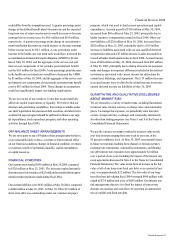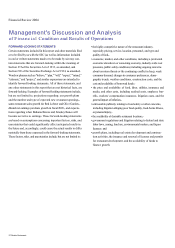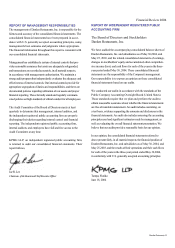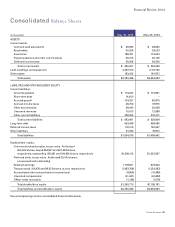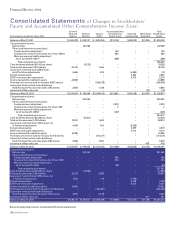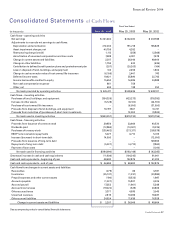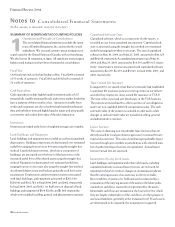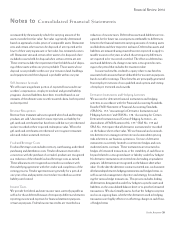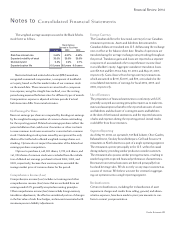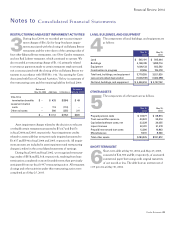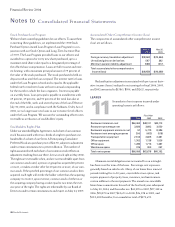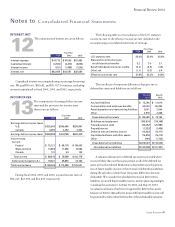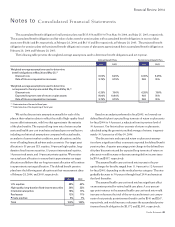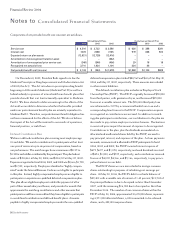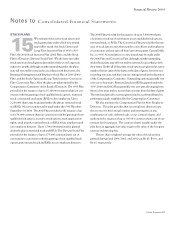Red Lobster 2004 Annual Report Download - page 41
Download and view the complete annual report
Please find page 41 of the 2004 Red Lobster annual report below. You can navigate through the pages in the report by either clicking on the pages listed below, or by using the keyword search tool below to find specific information within the annual report.
Notesto
Consolidated Financial Statements
The weighted-average assumptions used in the Black Scholes
model were as follows:
StockOptions
GrantedinFiscalYear
2004 2003 2002
Risk-freeinterestrate 2.62% 4.37% 4.50%
Expectedvolatilityofstock 30.0% 30.0% 30.0%
Dividendyield 0.2% 0.2% 0.1%
Expectedoptionlife 6.0years 6.0years 6.0years
Restricted stock and restricted stock unit (RSU) awards are
recognized as unearned compensation, a component of stockhold-
ers’ equity, based on the fair market value of our common stock
on the award date. These amounts are amortized to compensa-
tion expense, using the straight-line method, over the vesting
period using assumed forfeiture rates for different types of awards.
Compensation expense is adjusted in future periods if actual
forfeiture rates differ from initial estimates.
Net Earnings Per Share
Basic net earnings per share are computed by dividing net earnings
by the weighted-average number of common shares outstanding
for the reporting period. Diluted net earnings per share reflect the
potential dilution that could occur if securities or other contracts
to issue common stock were exercised or converted into common
stock. Outstanding stock options issued by us represent the only
dilutive effect reflected in diluted weighted-average shares out-
standing. Options do not impact the numerator of the diluted net
earnings per share computation.
Options to purchase 4,643,389 shares, 3,952,618 shares, and
161,220 shares of common stock were excluded from the calcula-
tion of diluted net earnings per share for fiscal 2004, 2003, and
2002, respectively, because their exercise prices exceeded the
average market price of common shares for the period.
Comprehensive Income (Loss)
Comprehensive income (loss) includes net earnings and other
comprehensive income (loss) items that are excluded from net
earnings under U.S. generally accepted accounting principles.
Other comprehensive income (loss) items include foreign currency
translation adjustments, the effective unrealized portion of changes
in the fair value of cash flow hedges, and amounts associated with
minimum pension liability adjustments.
Foreign Currency
The Canadian dollar is the functional currency for our Canadian
restaurant operations. Assets and liabilities denominated in
Canadian dollars are translated into U.S. dollars using the exchange
rates in effect at the balance sheet date. Results of operations are
translated using the average exchange rates prevailing throughout
the period. Translation gains and losses are reported as a separate
component of accumulated other comprehensive income (loss)
in stockholders’ equity. Aggregate cumulative translation losses
were $9,960 and $10,354 at May 30, 2004, and May 25, 2003,
respectively. Gains (losses) from foreign currency transactions,
which amounted to $(53), $(105), and $33, are included in the
consolidated statements of earnings for fiscal 2004, 2003, and
2002, respectively.
Use of Estimates
The preparation of financial statements in conformity with U.S.
generally accepted accounting principles requires us to make esti-
mates and assumptions that affect the reported amounts of assets
and liabilities and disclosure of contingent assets and liabilities
at the date of the financial statements, and the reported amounts
of sales and expenses during the reporting period. Actual results
could differ from those estimates.
Segment Reporting
As of May 30, 2004, we operated 1,325 Red Lobster, Olive Garden,
Bahama Breeze, Smokey BonesBarbeque & Grill and Seasons 52
restaurants in North America as part of a single operating segment.
The restaurants operate principally in the U.S. within the casual
dining industry, providing similar products to similar customers.
The restaurants also possess similar pricing structures, resulting in
similar long-term expected financial performance characteristics.
Revenues from external customers are derived principally from
food and beverage sales. We do not rely on any major customers as
a source of revenue. We believe we meet the criteria for aggregat-
ing our operations into a single reporting segment.
Reclassifications
Certain reclassifications, including the reclassification of asset
impairment charges and credits from selling, general, and admin-
istrative expenses, have been made to prior year amounts to con-
form to current year presentation.
41
Financial Review 2004


